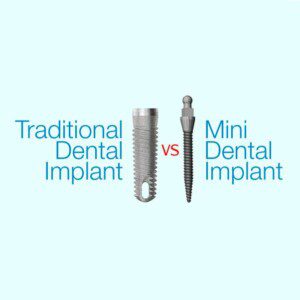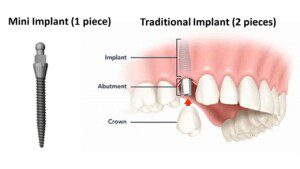Dental implants offer solutions that not only mimic the appearance of natural teeth but also their functionality and strength. Mini implants are a distinct and advantageous option.
Designed to provide a stable foundation for dental prosthetics, mini implants cater to a variety of patients, especially those who may not be suitable candidates for traditional dental implants due to factors like bone density or the desire for a less invasive procedure. This article delves into what mini implants are, how they compare to traditional implants, and the unique benefits they offer, shedding light on why they might be the ideal choice for certain patients.
Most commonly, mini implants effectively serve as long term support for dentures. They can also be used to support crowns in very narrow tooth spaces. For example, lower front teeth, where the space is narrow and the bone is often very thin from lip to tongue. Dr. McFadden is one of the pioneers in using mini implants to replace missing teeth in areas where there is little bone or a very narrow space between roots. These solutions have allowed many patients to avoid bone grafting or orthodontic treatment. In most cases, we place a temporary crown on the mini implant at the time of implant placement. No one leaves without teeth, EVER!
What are Mini Implants?
Mini implants are similar to regular implants but are smaller, often less than 3.0 mm, in diameter. They are used most often when there is inadequate width of bone to place standard sized implants.
Mini implants can be used in a variety of ways to replace missing teeth. They are typically easier to place and less expensive than regular implants. Many dentists only place mini implants. It should be obvious that a mini implant cannot and should not be used in all applications. However, when used properly they are a fantastic adjunct to full spectrum implant practice.

Differences Between Mini Implants and Traditional Implants
Mini implants and traditional dental implants serve the same primary purpose: to provide a foundation for replacement teeth that look, feel, and function like natural teeth. However, there are several key differences between these two types of implants that can influence a patient’s choice based on their individual needs, preferences, and dental conditions.
- Size and Diameter: The most notable difference lies in their size. Mini implants are smaller than traditional implants, with a diameter generally less than 3mm, whereas traditional implants typically range from 3.5mm to 6mm. This smaller size makes them a suitable option for patients who may not have sufficient bone for regular implants without undergoing a bone graft.

- One Piece vs 2 pieces:Mini implants are different than regular implants in that there is only one part. The implant itself. There are no abutments. A mini implant is made of just one piece titanium screw with a ball-shaped head for denture stabilization or a square prosthetic head for fixed applications like a crown, instead of the classic abutment. Mini implants protrude over the gum surface when they are placed into the bone; conventional implants are placed under the gums, and even with, or below the gum level.
- Surgical Procedure:Mini implants can be placed using less invasive techniques, sometimes requiring no flap surgery, which means the gum tissue is not cut and peeled back. This can lead to shorter healing times and result in less discomfort post-surgery compared to regular implants, which often require a more invasive procedure with a longer healing period.
- Bone Density Requirements:Due to their smaller size, mini implants require less bone, making them an excellent option for patients who have experienced bone loss and cannot undergo a bone graft for health or personal reasons. Traditional implants, on the other hand, need a certain level of bone height, weight and density to ensure the stability of the implant.
- Cost:Generally speaking, mini implants are less expensive than traditional implants. This cost difference is due to the less invasive nature of the procedure required to place mini implants, as well as the smaller size and material cost of the implants themselves.
- Usage:Mini implants are most often used to stabilize lower dentures for patients with inadequate bone width for regular implants. In some cases, they can be used immediately after placement. Traditional implants, with their larger size and greater stability, are used for a wider range of applications, including supporting single crowns, bridges, and dentures on both the upper and lower jaws. With that said, sometimes mini implants can be used for crowns for smaller teeth in small spaces. (But only sometimes.)
- Longevity and Durability:Traditional implants have a much longer track record and are considered more durable over the long term. They are designed to last a lifetime with proper care and maintenance. Mini implants, while effective, may not have the same longevity and are sometimes considered a temporary solution or an option for patients who are not candidates for traditional implants. (The average lifespan of mini implants is around 6-9 years, in comparison to decades for regular implants). They are very often considered a last resort option (for denture wearers with very limited bone).
- Immediate Load Capacity:In some cases, mini implants can be loaded with replacement teeth immediately or very soon after placement. Traditional implants, however, usually require a period of osseointegration. This is where the implant integrates with the bone. This osseointegration process can often take several months before the final crown or denture can be placed.
Advantages of Mini Implants
- Minimally Invasive Procedure: One of the most significant advantages of mini implants is the minimally invasive nature of their installation. Unlike traditional implants, mini implants require less bone structure for placement, which means the surgery is less complex and is typically completed in a single visit. This less invasive approach results in minimal discomfort and a quicker recovery time for patients.
- Less Expensive: Mini implants are more affordable than traditional dental implants. Their smaller size and the simplified surgical procedure reduce the overall cost, making them an accessible option for a broader range of patients seeking dental restoration solutions.
- Immediate Load: In many cases, mini implants can be loaded immediately, allowing patients to leave the dentist’s office with their replacement teeth in place after just one appointment. This immediate functionality is a significant advantage for patients who cannot afford to wait for the long healing times associated with traditional implants.
- Bone Preservation: Mini implants help to preserve bone and maintain the facial structure. The stimulation provided by the implant post mimics that of a natural tooth root, promoting bone health and preventing bone loss that often occurs with missing teeth.
- No Need for Bone Grafting: If a patient has experienced significant bone loss, traditional implants often require bone grafting. This adds to the complexity, cost and recovery time of the procedure. The much smaller size of mini implants usually eliminates the need for bone grafting. For this reason, it makes them suitable for patients with reduced bone density who are not candidates for traditional implants.
- Stability for Dentures: Mini implants should be considered for retaining an overdenture prosthesis as an alternative treatment when standard implant placement is not possible. For patients who suffer from denture dissatisfaction, mini implants can provide much-needed stability of removable overdentures. An overdenture “snaps” onto them with little fittings inside the denture that fit onto the implant. This reduction of slippage and movement improves the patient’s comfort, and greatly enhances their ability to eat and speak confidently.
- Good for Narrow Spaces: Mini implants are often a good option for replacing teeth in small spaces, such as lower front teeth. They are not recommended for molars, because the (large) tooth size vs the (tiny) supporting implant size is inadequate for any significant chewing. They’re usually reserved for smaller teeth toward the front of the mouth.
- High Success Rate: Mini implants have a high success rate (95% – 99%) and are known for their durability and longevity. With proper care and maintenance, they can last many years, providing a long lasting solution for missing teeth.
- Improved Oral Health: By filling the gaps left by missing teeth, mini implants help to maintain alignment and prevent the remaining teeth from shifting. This allows for proper chewing of food and better digestion. This opens the door once again for a wide variety of healthy foods that missing teeth make impossible to eat comfortably. They also facilitate better oral hygiene, as there are no brackets or wires to contend with, unlike traditional braces or bridges.
When are Mini Implants a Good Fit?
Patients with Inadequate Bone Density or Bone Loss
Individuals who have experienced bone loss or have inadequate bone density, making them ineligible for traditional implants, may find mini implants to be an ideal solution.
Edentulous Patients Seeking Implant Treatment Options
Edentulous patients (those lacking teeth) can benefit from mini implants as a stable and durable implant treatment option without the need for extensive surgical procedures or bone grafting.
Patients Looking for a Less Invasive Alternative
Mini implants offer a less invasive alternative to conventional implants, appealing to patients seeking simpler and less discomforting dental restoration methods.
When are Mini Implants NOT a Good Fit?
Patients with Clenching or Grinding Habits
Individuals who grind or clench their teeth are not good candidates for mini implants. Teeth grinding easily damages and wears down mini implants much more quickly than regular dental implants. Proactive use of a night guard may help prevent this from happening if the patient only grinds at night and is diligent with wearing it.
What is the Procedure?
Mini implants are placed into the jawbone through the gum tissue or after a small incision. Placement of mini implants is usually very simple for the patient and most can resume normal activities immediately. Most patients experience immediate results and can often eat their first meal within a few hours.
What is the cost?
The cost varies greatly depending upon the region, doctor’s training and number of implants. For single tooth applications expect to pay $ 1,700 – 3,000. For mini implant overdentures, $3,500 – 7,000.
Conclusion
Mini implants stand out as a versatile and innovative solution in the field of dental prosthetics. With their minimally invasive installation process, cost-effectiveness, immediate load capacity, and ability to preserve bone while offering stability to dentures, they present a compelling option for many patients. They are especially suited for edentulous patients, for those with inadequate bone density, or individuals seeking a less invasive alternative. Mini implants blend simplicity, efficiency, and effectiveness.
As dental technology advances, the role of mini implants in providing a high-quality, long-term solution for missing teeth becomes increasingly significant, offering patients improved oral health, enhanced comfort, and the confidence to smile freely.
Contact us today to schedule a consultation and find out how our mini implant tooth replacement services can benefit your oral health and appearance.

